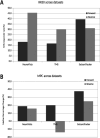A multi-dataset time-reversal approach to clinical trial placebo response and the relationship to natural variability in epilepsy
- PMID: 29102709
- PMCID: PMC5722663
- DOI: 10.1016/j.seizure.2017.10.016
A multi-dataset time-reversal approach to clinical trial placebo response and the relationship to natural variability in epilepsy
Abstract
Purpose: Clinical epilepsy drug trials have been measuring increasingly high placebo response rates, up to 40%. This study was designed to examine the relationship between the natural variability in epilepsy, and the placebo response seen in trials. We tested the hypothesis that 'reversing' trial direction, with the baseline period as the treatment observation phase, would reveal effects of natural variability.
Method: Clinical trial simulations were run with time running forward and in reverse. Data sources were: SeizureTracker.com (patient reported diaries), a randomized sham-controlled TMS trial, and chronically implanted intracranial EEG electrodes. Outcomes were 50%-responder rates (RR50) and median percentage change (MPC).
Results: The RR50 results showed evidence that temporal reversal does not prevent large responder rates across datasets. The MPC results negative in the TMS dataset, and positive in the other two.
Conclusions: Typical RR50s of clinical trials can be reproduced using the natural variability of epilepsy as a substrate across multiple datasets. Therefore, the placebo response in epilepsy clinical trials may be attributable almost entirely to this variability, rather than the "placebo effect".
Keywords: Big data; Placebo; Placebo effect; Randomized clinical trial; Seizure diary; Simulation; Statistics.
Published by Elsevier Ltd.
Conflict of interest statement
None of the authors has any conflict of interest to disclose.
Figures



Similar articles
-
Natural variability in seizure frequency: Implications for trials and placebo.Epilepsy Res. 2020 May;162:106306. doi: 10.1016/j.eplepsyres.2020.106306. Epub 2020 Mar 6. Epilepsy Res. 2020. PMID: 32172145 Free PMC article.
-
Does accounting for seizure frequency variability increase clinical trial power?Epilepsy Res. 2017 Nov;137:145-151. doi: 10.1016/j.eplepsyres.2017.07.013. Epub 2017 Jul 25. Epilepsy Res. 2017. PMID: 28781216 Free PMC article.
-
An estimate of placebo effect of repetitive transcranial magnetic stimulation in epilepsy.Epilepsy Behav. 2011 Feb;20(2):355-9. doi: 10.1016/j.yebeh.2010.12.005. Epub 2011 Jan 7. Epilepsy Behav. 2011. PMID: 21216200 Free PMC article.
-
Transcranial magnetic stimulation for the treatment of epilepsy.Cochrane Database Syst Rev. 2021 Apr 15;4(4):CD011025. doi: 10.1002/14651858.CD011025.pub3. Cochrane Database Syst Rev. 2021. PMID: 33884611 Free PMC article.
-
Placebo in epilepsy.Int Rev Neurobiol. 2020;153:231-266. doi: 10.1016/bs.irn.2020.03.033. Epub 2020 Jun 9. Int Rev Neurobiol. 2020. PMID: 32563290 Review.
Cited by
-
Factors associated with placebo response rate in randomized controlled trials of antiseizure medications for focal epilepsy.Epilepsia. 2025 Feb;66(2):407-416. doi: 10.1111/epi.18197. Epub 2024 Dec 21. Epilepsia. 2025. PMID: 39707877 Free PMC article.
-
Prospective validation study of an epilepsy seizure risk system for outpatient evaluation.Epilepsia. 2020 Jan;61(1):29-38. doi: 10.1111/epi.16397. Epub 2019 Dec 2. Epilepsia. 2020. PMID: 31792970 Free PMC article.
-
Does missing medication acutely change seizure risk? A prospective study.medRxiv [Preprint]. 2025 Jun 7:2025.06.06.25329144. doi: 10.1101/2025.06.06.25329144. medRxiv. 2025. PMID: 40502567 Free PMC article. Preprint.
-
Development and Validation of Forecasting Next Reported Seizure Using e-Diaries.Ann Neurol. 2020 Sep;88(3):588-595. doi: 10.1002/ana.25812. Epub 2020 Jul 9. Ann Neurol. 2020. PMID: 32567720 Free PMC article.
-
Inductive reasoning with large language models: A simulated randomized controlled trial for epilepsy.Epilepsy Res. 2025 Mar;211:107532. doi: 10.1016/j.eplepsyres.2025.107532. Epub 2025 Feb 24. Epilepsy Res. 2025. PMID: 40020525
References
-
- Kwan P, Brodie MJ. Early identification of refractory epilepsy. N Engl J Med. 2000;342:314–319. - PubMed
-
- Institute of Medicine (U.S.), Committee on the Public Health Dimensions of the Epilepsies, England MJ. Washington, DC: National Academies Press; 2012. [accessed Aug 28, 2014]. Epilepsy across the spectrum promoting health and understanding. http://www.nap.edu/catalog.php?record_id=13379. - PubMed
-
- PhRMA. Profile Biopharmaceutical Research Industry. 2015 http://www.phrma.org/sites/default/files/pdf/2015_phrma_profile.pdf.
-
- Rheims S, Perucca E, Cucherat M, et al. Factors determining response to antiepileptic drugs in randomized controlled trials. A systematic review and meta-analysis: Response to AEDs in Randomized Trials. Epilepsia. 2011 no-no. - PubMed
MeSH terms
Grants and funding
LinkOut - more resources
Full Text Sources
Other Literature Sources
Medical

